Sheriff Courts - remand and bail outcomes: occasional paper
A paper illustrating some of the key trends in bail and remand decisions, based on a new dataset prepared by Scottish Courts and Tribunals Services.
3 Results
3.1 Likelihoods of particular outcomes for the accused
Across the five years of hearings data from April 2016 to March 2021 analysed, the most likely outcome for the accused when their case calls for the first time in sheriff court is that they will be bailed (45%). The next most likely outcome is that they will be ordained (27%), followed by being remanded in prison (12%). Other possible recorded outcomes are that there was no further calling for that case-accused (9.4%)[3]; that a warrant was issued for arrest (2.1%)[4]; or some other outcome (such as the person being in care) or no outcome recorded (3.7%).
The likelihoods of different outcomes are shown for the two different procedure types (solemn or summary) in Figure 3. This shows that accused persons on solemn cases are far more likely to be remanded and far less likely to be ordained than accused persons on summary cases. The result that accused individuals on solemn cases are more likely to be remanded than those on summary cases is unsurprising in that solemn cases tend to involve more serious offences where public safety risks may be more likely. For example, Part III, Section 23C of the Criminal Procedure (Scotland) Act 1995 specifies that the “nature (including level of seriousness) of the offences before the court” is one of the factors to be considered by the court in their decision about bail.
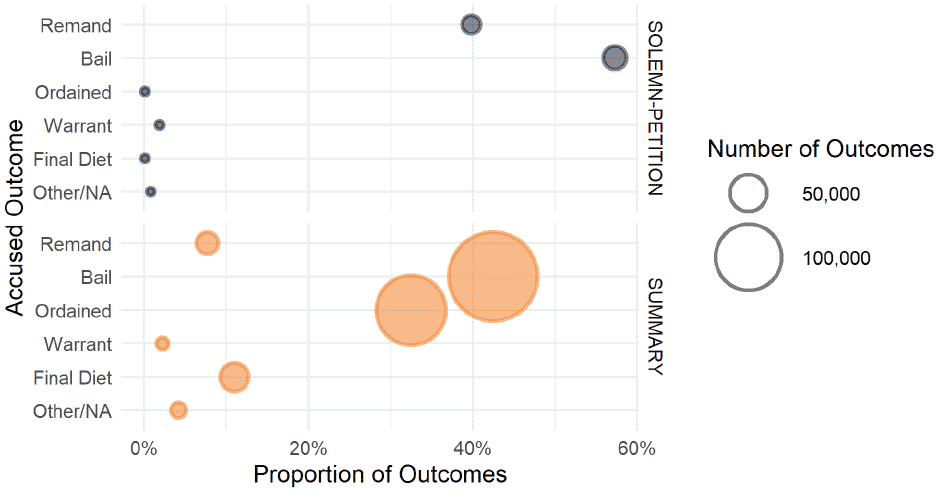
As well as the case procedure type (solemn or summary), the likelihood of particular outcomes for the accused varies by other factors, such as the appearance court type (custody/undertaking/other); and factors associated with the offence (such as the accused having a bail aggravator marking, meaning they breached bail on a previous case). Below, it is shown how the likelihood of an accused person being remanded varies for each of these:
Likelihood of remand
- by procedure type:
- sheriff summary complaint 7.7%
- solemn petition 40%
- by appearance court type:
- custody court 21%
- undertakings court 0.5%
- other court 0.2%
- by whether the accused has a bail aggravator marking (e.g. the accused was on bail at the time of the alleged offence):
- with bail aggravator 25%
- without bail aggravator 7.9%
It should be noted that these factors are not independent – for example, the high percentage of remand when the accused appears from custody is affected by custody cases being more common in solemn petition proceedings than in summary proceedings. This also does not mean these factors have a direct impact on the decision on whether to remand the accused individual
Different combinations of the factors above result in different likelihoods of particular outcomes, as shown in figure 4. Considering the combination of the three factors above, the case type with the highest likelihood of remand (63%) is a solemn petition case called in custody court where the accused has a bail aggravator marking[5].
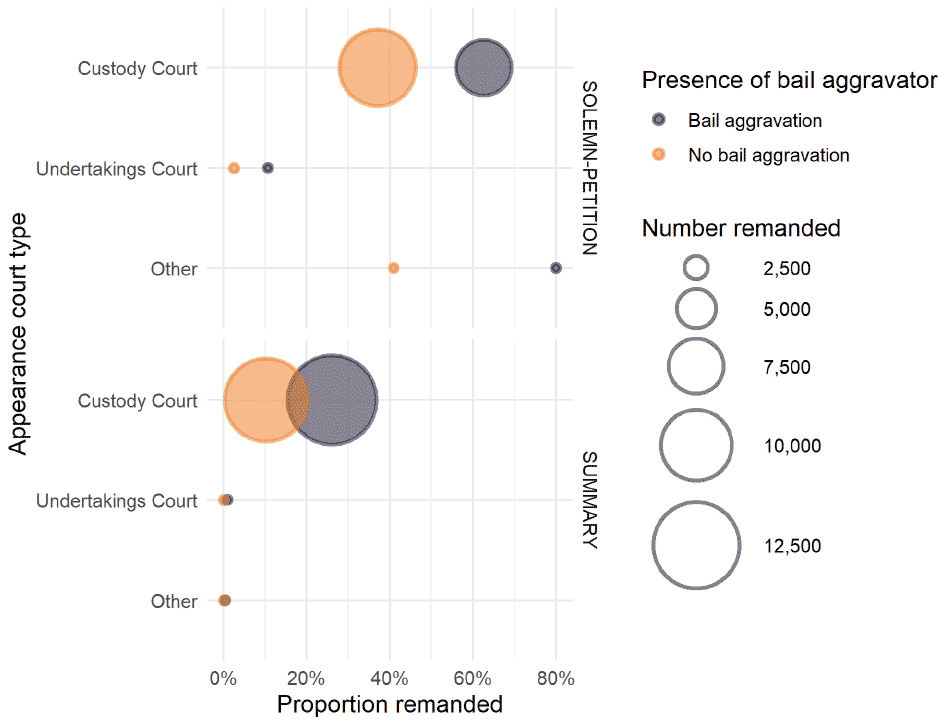
It should be noted that this paper does not consider any relationships between outcomes for the accused and:
- crime type
- different characteristics of the accused such as age or gender
These may be further explored in a future publication.
3.2 Trends in numbers and likelihoods of particular outcomes for the accused
This section explores trends in numbers and likelihoods of particular outcomes for accused persons over five years from 2016-17 up to and including 2020-21 (the first pandemic year).
3.2.1 Important context on system changes since the start of the pandemic
The data covers a five year period, but it is important to first note that there were a number of significant changes to the justice landscape in the final year of the data period during 2020-21, as the system was affected by the pandemic. The HM Inspectorate of Prosecution reported in September 2020[6] on the impacts made by the changes in the response to the pandemic, such as an update to Lord Advocate’s Guidelines[7] on liberation from police custody. As well as these changes, case law, as set out by the Appeal Court on the 3rd of April 2020[8], provided confirmation of how courts should approach their decision making regarding the consideration of bail that has been applied by the courts[9].
3.2.2 Trend in the numbers of first bail decision points in courts
Figure 5 shows the trend in the total number of accused first bail decision points for criminal cases over the five years to 2020-21 (see Methodology Annex for a description of which data have been included for first bail decision points in this analysis). Overall, the number of first bail decision points fell in Summary and increased in Solemn between April 2016 and March 2021. The reduction in the number of Summary diets outweighs the fall in Solemn ones, leading to an overall decline in the number of first bail decision points.
This trend continued in the first year of the Covid-19 pandemic (2020-21), with the total number of first bail decision points falling by 15% from the previous financial year. It is known that the pandemic reduced court capacity and court business, especially during the two lockdown periods. However, it is unclear whether this contributed to the fall in first bail decision points in 2020-21, or whether its impact was largely restricted to later court diets.
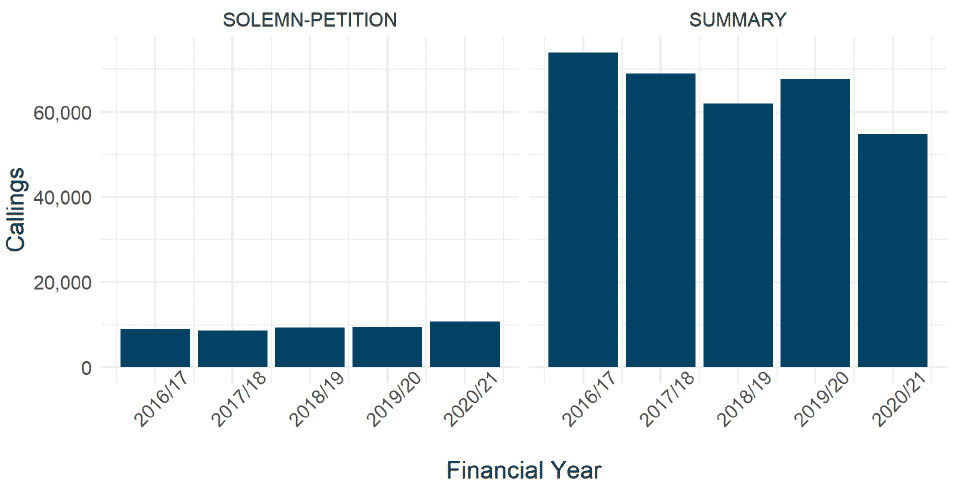
Section 3.1 of this report showed that procedure type and appearance court type are associated with different likelihoods of outcomes for the accused, so the changing profile of these callings in the pandemic year is important context for any changes in remand and bail volumes during the pandemic. Figure 6 shows that appearances from undertaking at first bail decision points rose from 2019-20 to 2020-21. This was the case for both Summary and Solemn procedures. However, while historically appearances from an undertaking are less likely to result in remand than appearances from custody (figure 4), it is not known whether this shift from custody appearances to undertaking had an impact on the overall likelihood of remand.
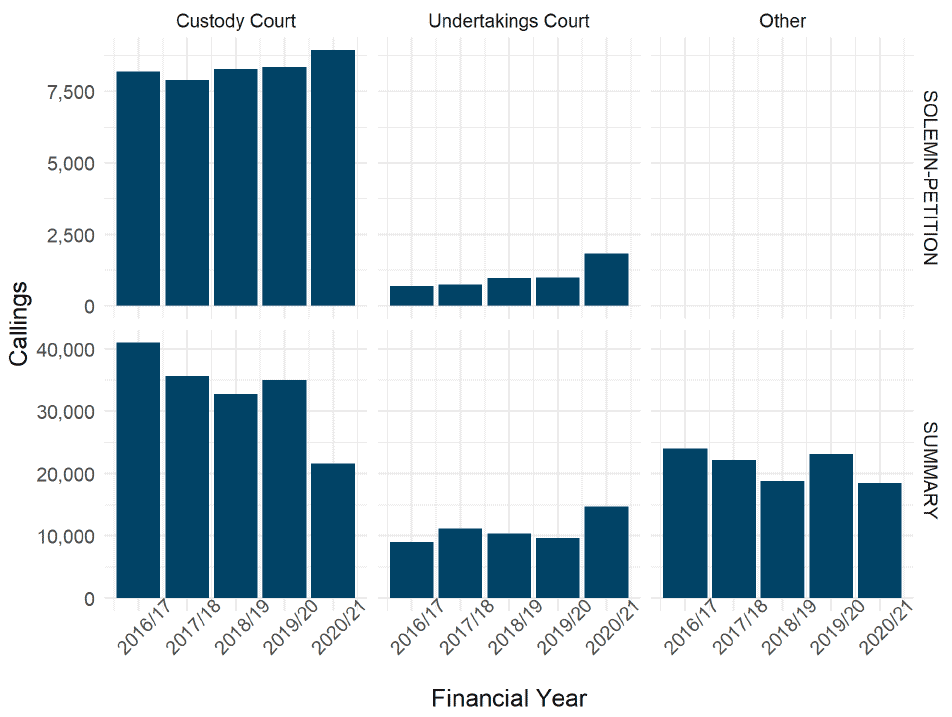
3.3 Accused outcome likelihoods for summary and solemn cases
Figure 7 shows the trends of different outcomes for accused on summary or solemn petition cases separately. Due to the much higher number of first bail decision points in summary cases, the overall trend matches that of summary cases, with all outcomes (e.g., remand, bail) falling in number in the first pandemic year (2020-21). The greatest relative fall of these was in cases resulting in an outcome other than remand, bail or ordained (21%), followed by numbers with an outcome of remand, an 18% fall from the previous year, and a notable change from the relatively stable level of remand arrivals over 2016-17 to 2019-20.
However, this trend in remand outcomes from Summary diets, which fell by more than one-third (38%), was in contrast to Solemn remand outcomes, which were in fact higher in 2020-21 than in 2019-20. Bail outcomes for Solemn first bail decision points also increased in 2020-21 by 17% from 2019-20.
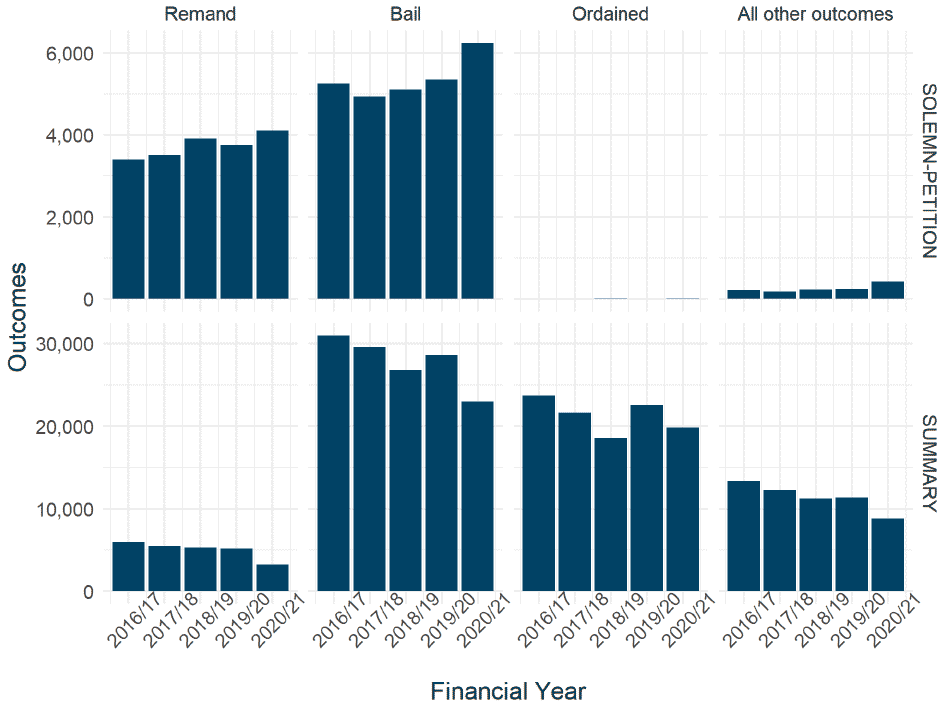
One of the factors associated with an increased likelihood of remand is whether the accused person has a bail aggravator marking (the accused was on bail at the time of the alleged offence). As figure 4 shows, a previous bail breach increases the likelihood of remand. Focussing specifically on Solemn first bail decision points, figure 8 shows that most of the increase in bail outcomes, and all of the increase in remand outcomes, during the first pandemic year (2020/21), came from cases with bail aggravations.
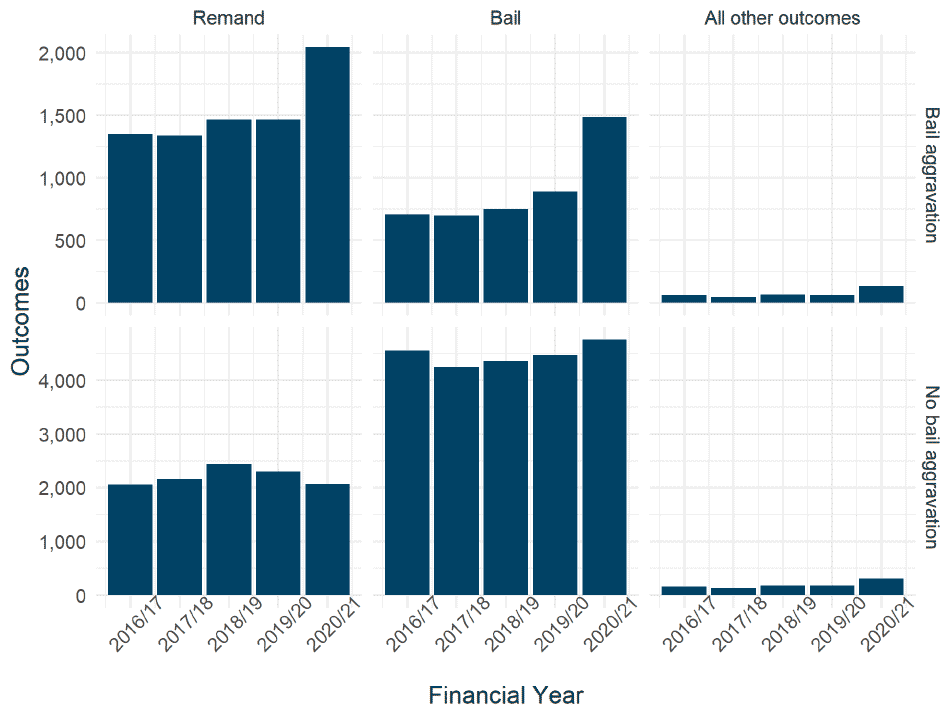
The increase in bail and remand outcomes for bail aggravation cases during the pandemic resulted in part from a sharp increase in such cases. Figure 9 shows a 51% increase in the volume of bail aggravation cases. In contrast, cases without any bail aggravation increased by only a small amount (3%) in line with the existing trend during 2020/21.
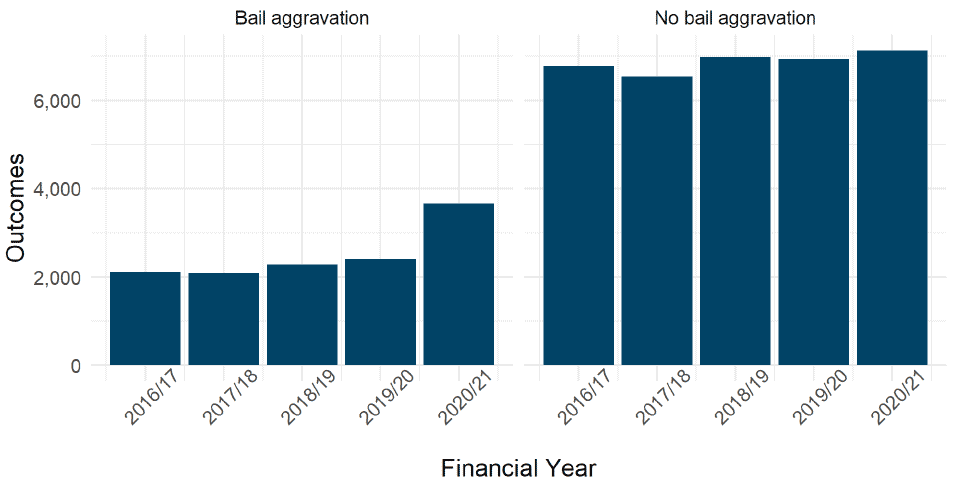
While out of the scope of this paper, this begs the question of why there has been such a significant increase in bail aggravations. It is expected that the number of bail aggravations will be in some way related to the number of people on bail and their length on bail. Therefore, delays in hearings resulting from the pandemic, which potentially increased the number of people on bail and extended the period of time that people spent on bail, could have contributed to the increased number of bail aggravations.
As figure 10 shows, cases with and without bail aggravations both saw a small reduction in the proportion of cases resulting in remand during 2020/21, with a corresponding increase in bail. This continues a trend that began a year earlier. Therefore, the pandemic year increase in remand outcomes resulted in large part from an increase in bail aggravation cases more than counter-acting a reduction in remand likelihood. The increase in bail outcomes in the same period resulted from both an increase in overall cases and an increase in bail likelihood.
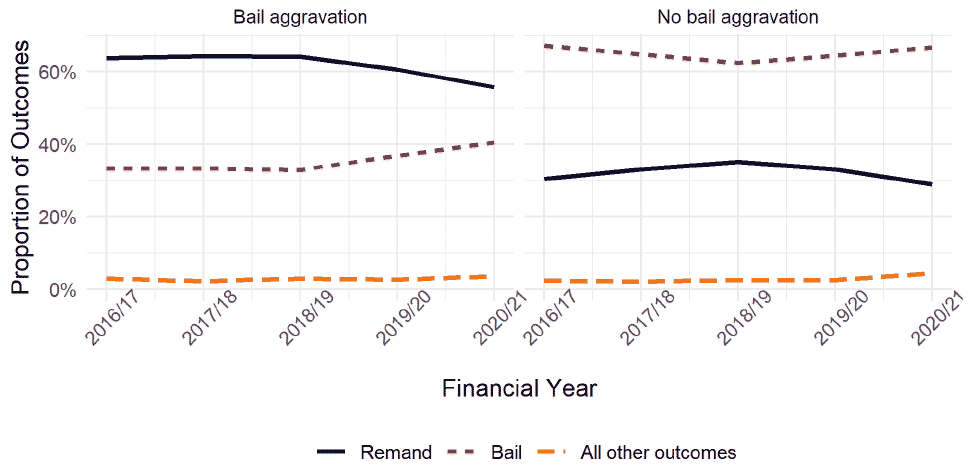
This increasing likelihood of bail outcomes for solemn first bail decision points is another factor leading to an increased bail population. This may be a contributory factor to the increase in bail aggravations discussed previously in figure 9, though it is unlikely to be the only factor given bail likelihood began increasing well before the sharp increase in bail aggravations.
Contact
Email: Justice_Analysts@gov.scot
There is a problem
Thanks for your feedback